What’s the most challenging part of coyote hunting? Most predator hunters would agree, it’s trying to track a wounded coyote. Even hurt, these elusive critters sometimes leave less sign behind than a lizard tiptoeing across bare rock.
It is a skill you can learn, however, and one you’ll get to practice in the field if you coyote hunt long enough.
And…
Once you pull the trigger, you have duty to do everything you can to recover that coyote.
Your efforts to track a wounded coyote say a lot about you.
A careless, unethical hunter does nothing more than walk to the area the coyote was standing in when shot at, look around for a moment, and, finding nothing right away, calls their shot a miss.
An ethical hunter uses the skills they learned in their Hunter’s Education course and won’t quit the track unless they’ve searched at least 100 yards for blood evidence. They will continue if they do find blood until they have exhausted all the evidence.
Always track a wounded coyote safely.
There’s few creative ways to get hurt looking for a wounded predator. All of them are preventable accidents.
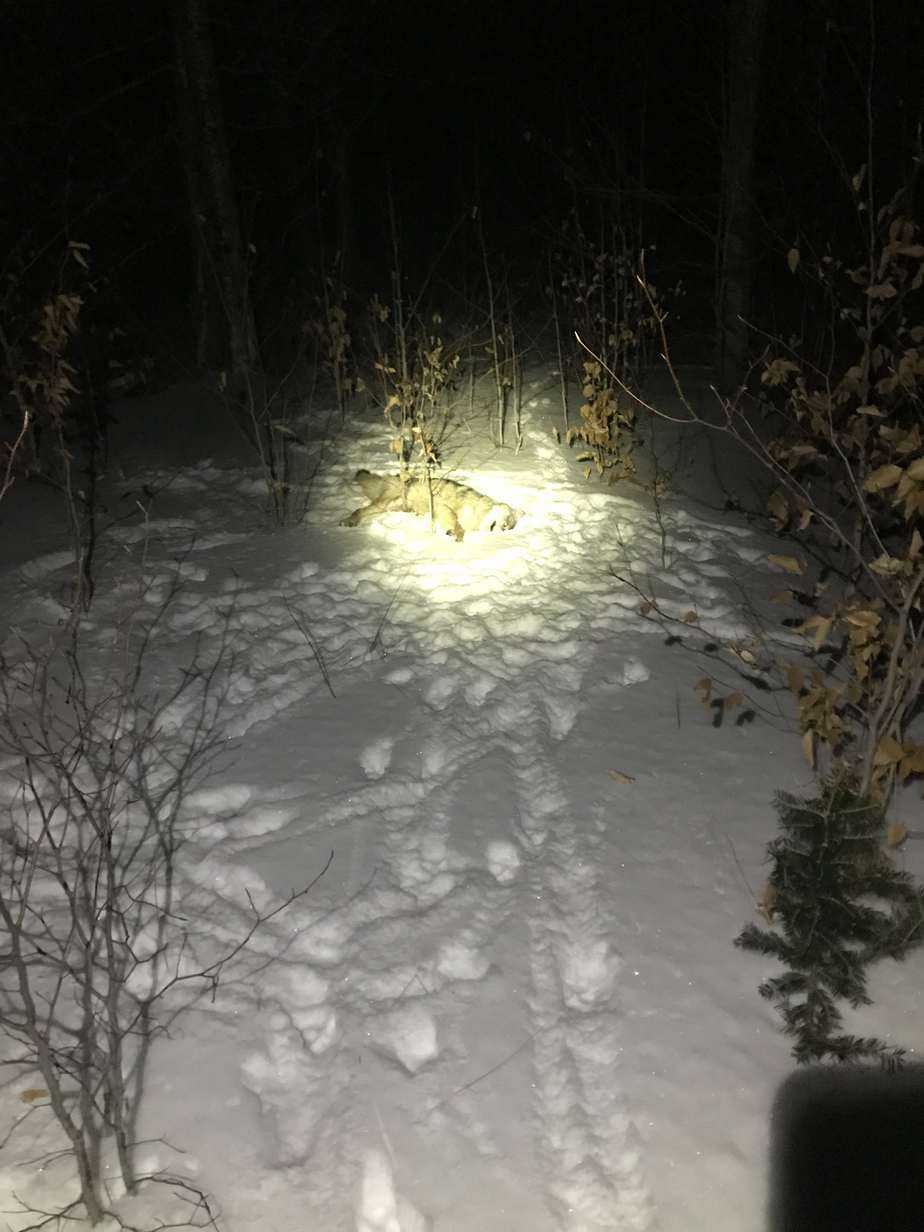
Coyote hunting without a plan.
A proper hunting plan contains a map of the areas you will hunt and your expected return date and time. Make a copy of it, give it to a responsible person, and if they don’t get a call from you saying you are safely home, they alert the authorities.
Getting shot by another coyote hunter.
Look, the dang coyotes don’t see red! You can call and hunt predators during the day while wearing hunter orange. When you start crawling around tracking wounded coyotes in the woods, bright orange also helps another hunter realize that you are a human.
Getting lost while you track a wounded coyote.
With your eyes on the ground and your attention focused like a laser, it’s easy to get lost. It happens to all of us. We look up, turn in a circle, and wonder where the hell we are.
Hey, the only deadly sin of tracking is getting lost. Try and avoid that, okay, buddy?
Here’s where your coyote hunting plan saves you. Hours after you fail to call in, your buddy calls the cops. The cops use your map and eventually find you. If you don’t have a harmonica to play until you get rescued, you can practice using the best closed reed coyote call while you wait.
Getting hurt.
Falls and bites top the list here.
Most predator hunting is in the winter with its cold temperatures, deep snows, and icy slopes. The increased risk of a disabling fall, exposure to the elements, and the likelihood you’ll be hunting alone should make you realize that tracking at night is a no-no.
Not getting bit is a matter of testing the coyote’s reaction to having its eyes touched with a long stick. No other method, including the dog’s stillness and its dramatic blood loss, is foolproof.
That coyote didn’t get me, but I have had a fox grab me. My hand hurt for a whole week. Be careful!
Inexpensive tools to help you track a wounded coyote.
Your eyes and ears. You’ll naturally expect the evidence to be on the ground, but keep your head up and on a swivel. Not only is it a great way to avoid getting a branch in your eyes, but it’s also the only way you can scout ahead for potential hiding places or notice that a wounded coyote staring at you 20 yards away.
Orange marking flags. Place an orange marking flag at every spot you find blood from the original point of impact until you find the coyote. The first 100 yards will give you the most critical information you’ll need—the direction of flight.
Please note: I get a small commission—at no extra charge to you— if you use any links in this article to make a purchase.
Hydrogen peroxide. Hydrogen peroxide makes blood turn white and frothy. Old, dry, or invisible to the naked eye, a quick spritz of hydrogen peroxide stored in a colored spray bottle will make the blood stand out.
A blood light. A blood light turns blood into a neon sign and everything else into a dull grey background. At night, an indispensable tool. For years, my favorite was unavailable, but Amazon now has a few back in stock. Get this one!
Expensive tools to help a coyote hunter track a wounded coyote.
Thermal Viewer. I never recommend buying a thermal viewer, but if you need to find a wounded deer or a dead fox it’s perfect. Other than that, they are useless, expensive toys. Spend your money buying a thermal scope, instead.
I hope you do not buy one. If you still think you need one, I hope Amazon.com is out of stock. Seriously, save your money.
Thermal scope with a camera. I recommend the ATN Thor 4. It is affordable and has a good range (130 yards). It also allows you to capture your shot on video and review it to determine the coyote’s reaction to the shot and the direction it fled in. It’s also perfect for helping you not only track a wounded coyote but place a follow-up shot on it if needed.
The best thing to do before you track a wounded coyote.
Always take your shot using the least amount of magnification required. The widest view of your target allows you to observe and track the coyote after you have fired. Knowing how it reacts and the direction it moves in will help you begin your track.
To track a wounded coyote, first note its reaction to being shot at.
The instant you shoot, the coyote will react in five possible ways. Here’s what each reaction could mean.
- Runs away. You may have missed or had a round that failed to fragment and passed through without hitting a vital organ (pencil holed).
- Spins in a circle. Your round hit somewhere behind the shoulder. The coyote is spinning as it tries to bite the source of pain.
- Drops flat. It could be fatally wounded, knocked out, or temporarily paralyzed. Sometimes, a hit is immediately fatal and the dog collapses straight to the ground. But, a glancing blow to the head can knock a coyote out for as long as 15 minutes. Another nonlethal injury is a round striking the neck. This can shock the spine causing temporary paralysis. A coyote wounded in the neck may regain its senses within 5 minutes and run off.
- Limps away. This could mean a paw, leg, or shoulder injury.
- Remains in the area. It may stare at you, run off a short distance and then return, or continue as if nothing had happened. The loud report of your rifle got the coyote’s attention, but did not alarm it for some reason. You’ll have time to determine what went wrong with your shot and shoot again. That coyote isn’t afraid of you.
When to take an immediate follow-up shot.
Reshoot the coyote immediately if:
- It is vainly struggling to regain its feet or suffering.
- It has fallen and attempts to raise its head or stand back up.
- It stops spinning and lifts its head into the air. It’s possible this dog is painfully wounded, but believes an unseen attacker bit it.
Protip: Once the coyote is down, keep your scope on it and start calling again for a few mintes using a coyote distress sound
.Coyote behavior 0-5 seconds after your shot.
A wounded deer may head downhill and make for water, but a wounded coyote will run for a place of known safety, despite the terrain.
In the first five seconds after the shot, the coyote will take one of four actions to reach that safe location:
- Missed or hit, a coyote will immediately turn in the direction it came from before being attacked. To a coyote, this direction equals safety.
- Once pointed in the right direction, it will use as much speed as possible to travel at least 100 yards. The coyote is attempting to break contact with you. It will not turn aside from this original escape route until it believes it is free of immediate danger.
- A lightly wounded coyote will (after 100 yards) use game trails to increase the distance from the point of attack, eventually turning for a known safe location.
- A badly wounded coyote will (after 100 yards) attempt to get into the heaviest cover available.
Below: A fatally wounded coyote heads back towards safety,
Before you start to track a wounded coyote.
Here are four steps to take before breaking your stand and starting your search for a wounded coyote. Follow them closely, and you’ll increase the odds of quickly recovering your coyote—without driving it too far into the woods.
- Study its reactions and determine if a short wait is needed. If it fell and then regained its footing and fled, wait five minutes before breaking your stand. Use the time to try a “Coyote in Distress” call to bring in other coyotes.
- Calm yourself down and be as quiet as possible.
- Approach, begin, and continue your track in as stealthy a manner as possible.
- Commit yourself to find your wounded coyote. You spent a great deal of time zeroing your rifle and you know you took a great shot. The odds are in your favor. Dedicate the next 100 yards to finding blood proof your shot was accurate.
Reading blood sign.
If you are an experienced bow hunter, there are two significant differences between tracking wounded deer and blood trailing a coyote.
Bowhunting occurs during the fall, but the fur-bearing season is in the winter. The colder temperatures quickly freeze the blood and give it a darker, duller appearance.
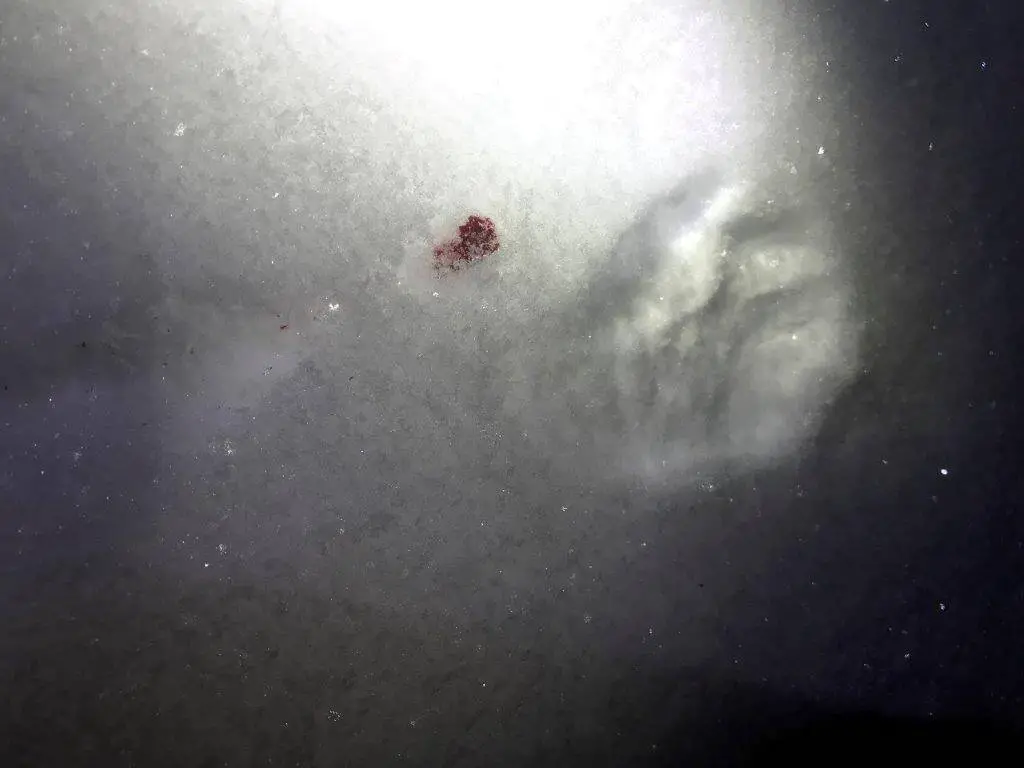
Coyote blood will also be lower to the ground and more widely spread than deer blood.
Blood color indicates wound location.
If your shot is perfectly placed, you will find bright red blood sprayed in an arc. That blood streamed from a severe exit wound, and your coyote is within 25 yards of where you shot it.
Pink blood, sporting air bubbles, indicates a lung wound. You have a short walk (under 50 yards) and will find your coyote using only the blood trail to track it.
Blood slightly darker than lung blood typically comes from a heart injury. Depending on the amount of damage, this means an easily tracked coyote who should drop with 100 yards.
A mix of bright and dark blood comes from a coyote hit by a bullet that damaged its stomach and lungs. If just damaged lightly in one or both lungs, this coyote will travel further than 100 yards but shouldn’t stop leaving an easily detected blood trail.
Dark, watery blood is from a stomach wound. Break out your marking flags, blood light, and thermal scope. You are in for a long track.
Reading the amount of blood.
Continuous, thick, long lines and large splashes equal heavy blood loss.
Short, thin lines with breaks in between them are from moderate blood loss.
Occasional drops indicate a light blood loss.
Blood on both sides of the trail is a means your round penetrated and exited the coyote.
A small trail of blood could come from a high hit on the body, or an entrance wound that is starting to clog up.
Pro tip: An individual blood drop can also tell you which direction the animal was moving in.
Breaking your stand and starting to track a wounded coyote.
Breaking your stand—putting your weapon on safe, shutting off your caller, and moving forward—begins your track’s first phase: the blood trailing
Well, hopefully, you will be blood trailing. As you’ll see later, blood trailing is much easier than eye-tracking.
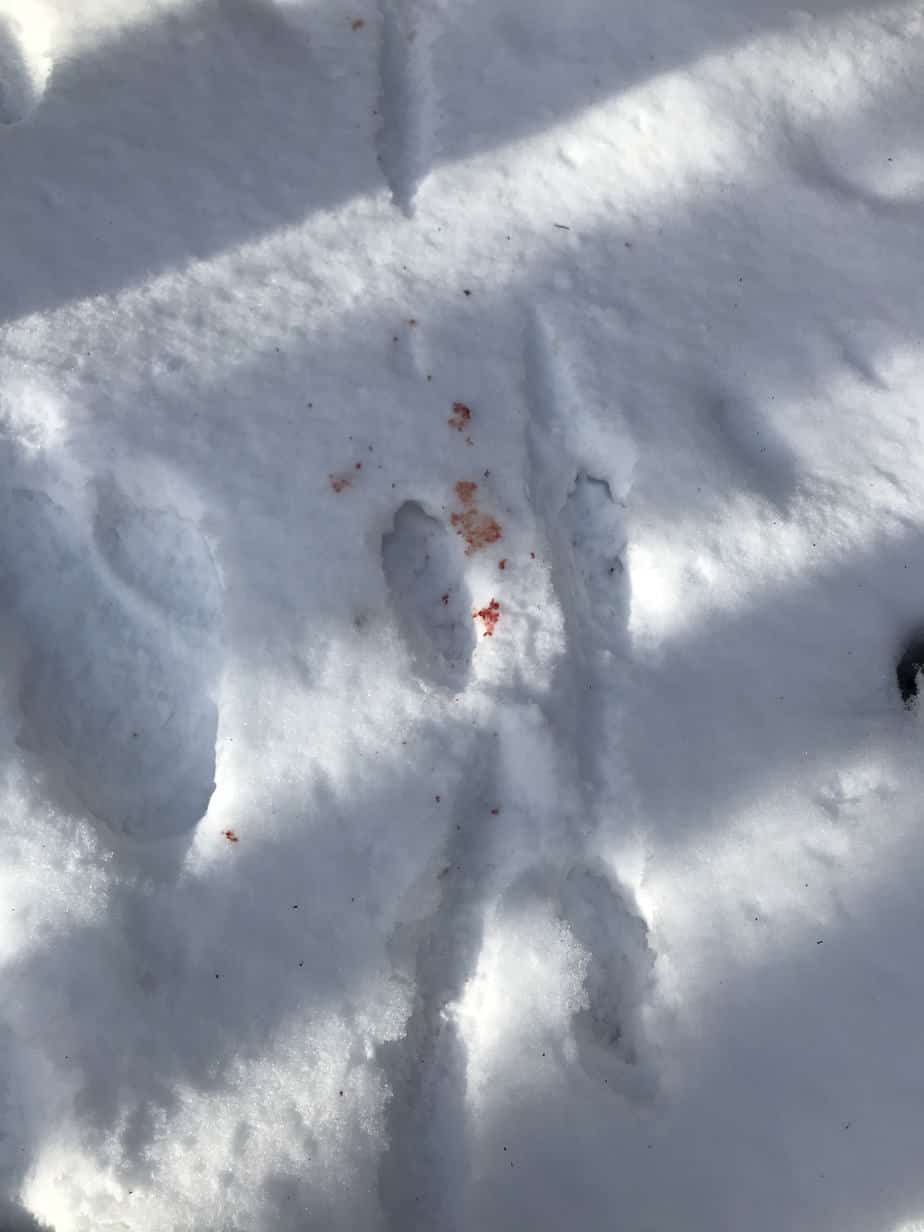
Start by carefully approaching the scene of the shooting like a homicide detective would; using great care not to step on, disturb, and ruin any valuable clues.
Look first for blood, flesh, or hair proving your bullet made some contact with the dog. If you find none, can you find where the round impacted?
Pro tip: In fresh snow, you might find where the bullet landed. Compare this location to the location of the coyote’s footprints. If the shot landed entirely outside the area the coyote stood in; you have all the clues you need to stop searching.
When to call it a miss and end the track.
If you see no reaction to being shot at other than flight, and there was no limp as the coyote fled, you can ethically call your shot a miss—if you do not find fur or blood within 100 yards.
How far does a bleeding coyote travel?
If you find blood at the scene, it may not seem like an sufficient amount to suggest a fatal injury. But even a drop or two here is significant. The coyote likely fled too fast for even a devasting wound to spill more than few drops.
As the coyote moves the first 100 yards from the scene, it’s powered by a factor of the amount of oxygen it has available and the size of the entry and/or exit wounds.
A lung shot coyote will pile up as many as 100 yards away. A coyote with an entry and exit wound through the middle of its torso and lungs? That coyote will stop forever within 25 yards.
The vast majority of fatally wounded coyotes will be found no more than 200 yards away and will leave a visible blood trail for you to follow. After 200 yards, however, tracking a wounded coyote gets more challenging as the blood usually stops flowing, and eye-tracking becomes necessary.
Pro tip: Flag every location you find blood in. Keep flagging it throughout your track.
Related: Using scat and tracks to find coyotes.
What happens to a bleeding coyote after 200 yards?
It often stops leaving a blood trail!
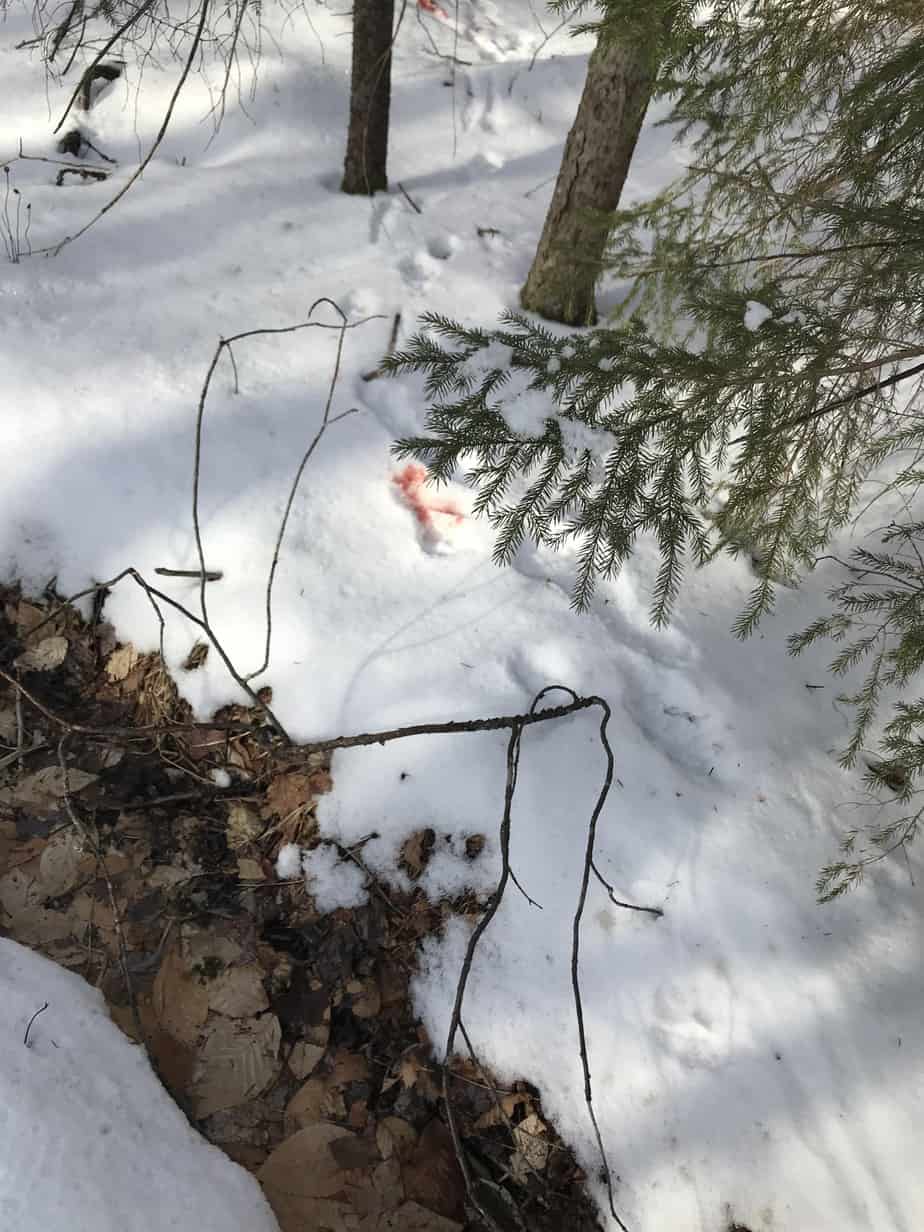
Why is a dog that gets 200 yards away going to stop bleeding? In a word, clogging. This obstruction of blood flow is caused by a blockage of flesh, fat, intestines, or other body tissues.
Consider a stomach wound. The initial blood (dark and watery) will flow freely until a section of the intestine get sucked into the exit. With the wound sealed, less and less blood exits. Soon, it’s a few drops every 5-10 yards. Eventually, you’ll find no more blood until the wound reopens.
If there is no exit wound, the body cavity may retain much of the blood. Until the cavity begins to overrun the edge of the injury, no more blood will fall to the ground.
How to track a wounded coyote without a blood trail.
After 200 yards, with what appears to be no other blood trail to follow, many coyote hunters mistakenly believe their target “got away.”
Instead of quitting, however, you should recognize an obvious fact; the wound did not magically heal itself. It’s just temporarily stopped flowing. The wound will reopen, and you will find the dog—if you connect the dots between the last blood sign at 200 yards and where the wound is disturbed again.
If you have a blood light, now’s the time to use it. Remember, the ground and vegetation will be a dull grey, but the blood will glow an unmistakable red.
If you have a thermal device, you only need to turn it on and continue scanning ahead. Look for the body heat of the coyote or check the ground for the warmer blood. If you can find neither, take the next step.
Get low and go slow.
Start by changing your position. Get on our hands and knees and begin eye tracking and slowly moving in the known direction the coyote was running.
At ground level, you will be forced to move slower, preserving evidence and getting close enough to it to notice specks of blood, overturned rocks, and trampled leaves.
Take a good long look around every few minutes. Is there an area nearby that could provide thick cover for a wounded coyote to bed down in? Is there a visible trail left on the grass that points out the path the animal took?
Flag all evidence. Scan with your thermal viewer and blood light.
Zigzag and hope for the worst; for the coyote, that is.
If you cannot find any more blood or other physical proof, stand up and return to your last flag. Take a deep breath and relax for a few minutes.
Look, you know the coyote did not just fly six inches above the ground, so there has to be some sign around.
The coyote had to be hauling butt in a desperate attempt to escape. It must have torn up some soil and left behind at least a single paw print, scuff mark, streak in the mud, or small pile of scattered leaves.
It may even be dragging itself around by now, slowing to a crawl. It could be leaning against a tree, checking back over its shoulder to see if it’s still being pursued. Dying perhaps, if not already dead. It has to be somewhere nearby.
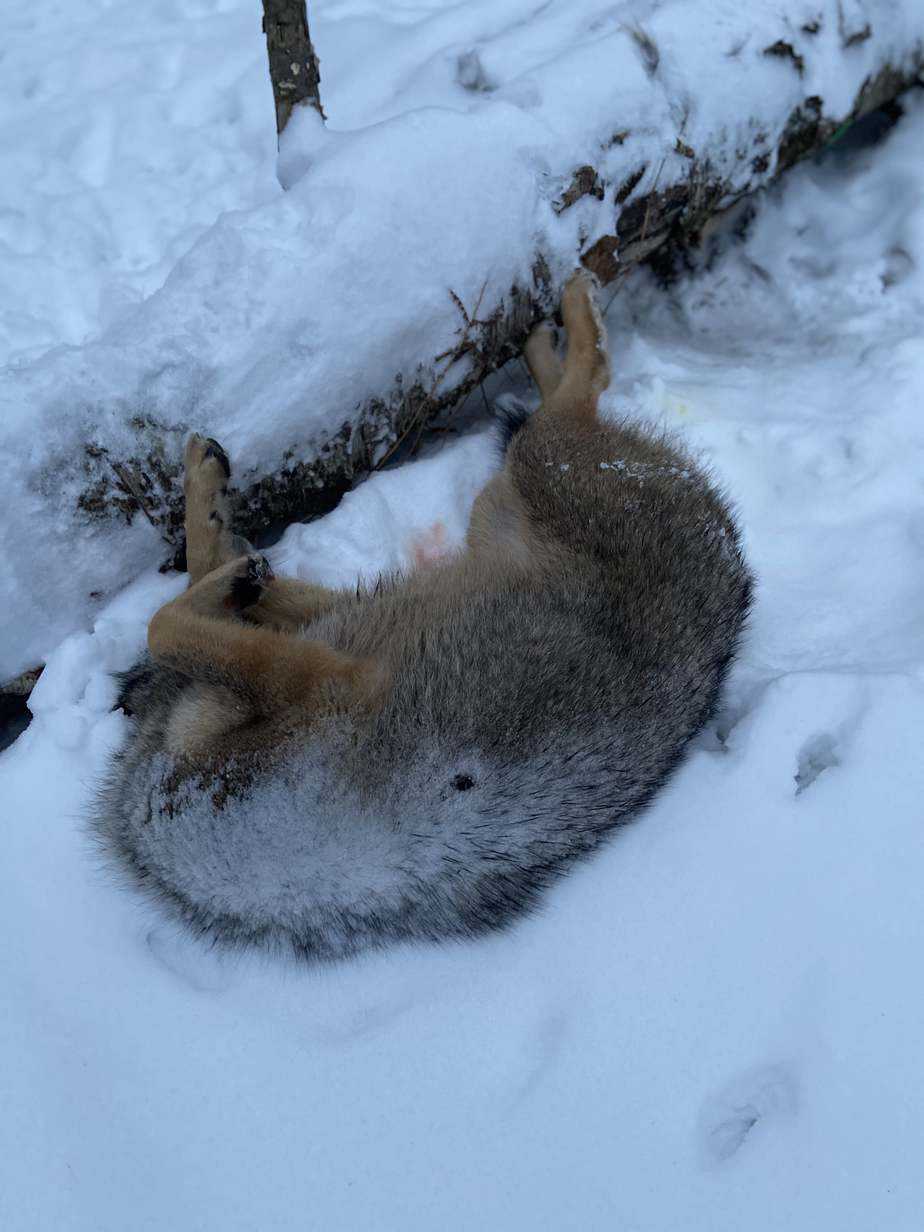
But one thing is certain, that wound is going to start leaving some more blood, and soon.
Ready to try one last trick?
Take a break and then restart your track.
Your safest bet, after you’ve taken a short break, is to continue in the direction the coyote went and begin searching in a zigzag pattern.
Now, still standing, begin walking forward while weaving a few yards to the left and right of the believed course. Increase the zigzag to at least 10 yards to either side after you are more than a 100 yards from the last flagged blood spot.
Remember: Always keep scouting ahead for the coyote or any place it could be hiding. Keep firing up that thermal and checking for new hot spots.
Eventually, two things will happen.
- The coyote will change direction to head for a known safe spot,likely heavily disturb the soil, or.
- The wound will begin to bleed again.
And the coyote’s wound will reopen. Even a slow-moving coyote is still going to leap over logs and climb hills. As it does, the action may dislodge the obstruction or cause a filled body cavity to spill its bloody contents.
Naturally, this means any steep embankment you encounter should get a thorough search. At the bottom of the embankment, look for tracks made in the moister ground. At the top, look for the blood the steep climb has allowed to start dripping again. When you find this new evidence, don’t forget to flag it.
How far can you go?
Tracking a wounded coyote takes a lot of effort and patience. But if you follow the blood, or successfully track a large bloodless area and then regain the blood trail, you’ll find your coyote and have one hell of a tale to tell.
The only real limits on tracking a wounded coyote are your physical abilities and property lines.
Every attempt to track a wounded coyote is a success.
Most coyote hunters will never read this sentence, let alone try this hard to track a wounded coyote. But even if you never find yourself needing, let alone using this information, you’ve already proven you have what it takes to preserve the sport of predator hunting.
I wish you well on your next stand, and, if needed, success the next time you track a wounded coyote.

